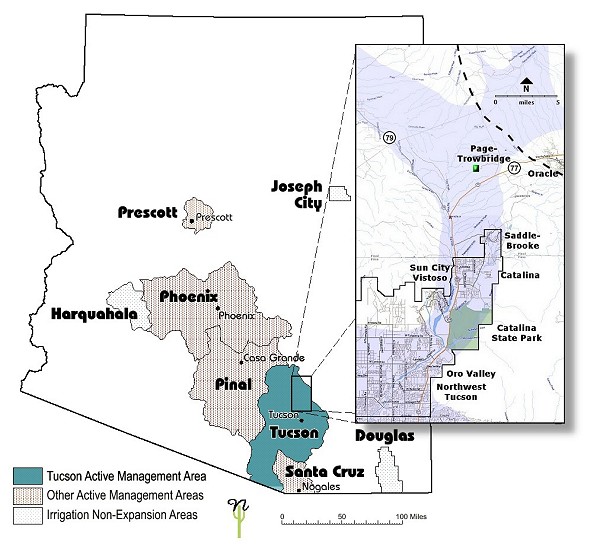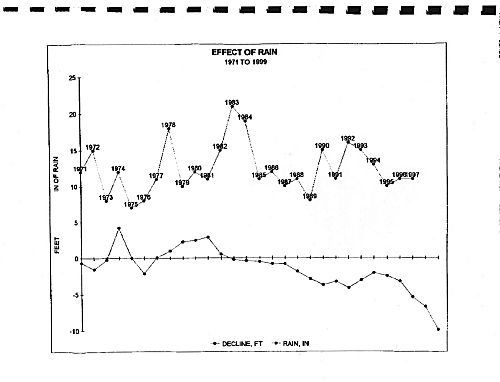|
JC Huntington, May 12, 2001 Introduction Because it is possible for a few individuals to make huge amounts of money by importing people to live in large, golf-oriented developments, we will be told that experts have determined that there is "plenty of water" to sustain several large, golf-oriented communities in the Oracle Junction area. Although Arizona Water law makes it appear as though there is sufficient water, the reality is quite different. In reality, groundwater in our active management area is being depleted much faster than it is being replaced. The regional aquifer that supplies water for Oracle is one of the few remaining aquifers in the Tucson AMA that is not suffering a severe overdraft. However, if proposed development projects in the area are allowed to be built, this situation will change and the regional aquifer will be depleted just as the other aquifers in the Tucson AMA are currently being depleted. The Tucson Active Management Area In 1980, when it was finally recognized that unrelenting groundwater pumping was sucking aquifers dry, the Arizona Legislature passed the Groundwater Management Act. Areas that needed special attention were designated as Active Management Areas (AMA's). The Department of Water Resources (ADWR) was established and given legal tools to manage groundwater use in the AMA's. The figure below shows the Tucson Active Management Area and the other AMA's. The area around Oracle Junction is shown in the inset, with the aquifer represented by a light blue color. The dashed line in the inset shows the boundary of the Tucson AMA. |

Source: ADWR
and Montgomery and Associates
Mark Cross, a hydrologist with Montgomery & Associates described the portion of the aquifer north of Oracle Junction as "pristine" -- in other words, the regional aquifer is relatively undefiled (at least as of now). |
|
A Very Large Overdraft In 1995, 301,881 acre feet of groundwater was withdrawn from the Tucson AMA and only 60,800 acre feet of water was recharged into it. This is an overdraft of 241,081 acre feet (78,556,484,931 gallons) of water. Overdrafts of this magnitude continue to this day despite the use of CAP water. The Tucson area's overdraft on ground-water in 2000 was 169,500 acre-feet (55,231,744,500 gallons). Thus, the aquifer north of Oracle Junction may be the last remaining intact aquifer in the Tucson AMA. Oro Valley affords and example of the more normal aquifer within the Tucson AMA. While the water level of the aquifer north of Oracle Junction is stable, the aquifer in Oro Valley area is being depleted to the point that the water level is dropping at a rate of 7 feet per year1. The effect of the overdraft on the water supply in Oro Valley is shown in the chart below2. The top line of the chart shows the amount of rainfall for the years 1971 to 1997. The bottom line shows the decline in the water level from 1971 to 2000. So, while rainfall is fairly constant, the amount of available groundwater is declining at a rather alarming rate. |
 |
| Development & Decline
A quick look at the map of the portion of the aquifer in the area of Oro Valley shows us that the portion of the aquifer suffering a dramatic decline in groundwater is coated with houses and golf-courses. (This is not too surprising -- the more you use a limited resource, the faster it is used up).
An Insane Response The sane response to the severe overdraft condition on the Tucson AMA would be to take steps to control it. The figure below shows the actual response to the severe overdraft problem. The figure shows the proposed developments that will pump water from the one of the last unsullied aquifers in the Tucson AMA. If these developments are allowed, a few years from now the decline in the water supply north of Oracle Junction will mimic that seen today in Oro Valley and Tucson. In other words, the response
to a severe depletion of groundwater in the Tucson AMA is to continue to
cover the aquifer with more houses and golf-courses.
A System of Aquifers Groundwater in the aquifer north of Oracle Junction moves to the south and helps replenish the water supply for the communities below Oracle Junction. Depleting water from the portion of the aquifer north of Oracle Junction will lower the water level and slow the movement of water to the south, exacerbating the overdraft problem in Catalina, Sun City Vistoso, Oro Valley and Northwest Tucson. |
Because of the saucer shape, wells on the margins of the aquifer will go dry before the wells near the deep part of the aquifer go dry, as illustrated below: 
|
| The Myth of Safe Yield
The goal of the Tucson AMA is to achieve safe yield by the year 2025 so that no more groundwater is pumped out of the aquifers in the Tucson AMA than can be naturally or artificially recharged. Like the Certificate of Assured Water Supply, the name "Safe yield" sounds good, but there is a little catch. In the case of safe yield, the catch is that the law allows the "replacement" water to be put back anywhere in the Tucson AMA. In the case of Willow Springs, SaddleBrooke Ranch, Eagle Crest and other proposed projects, the CAP water used to "replace" the water pumped from the aquifer north of Oracle Junction to feed the golf courses and residents in these new developments, will be recharged at the Avra Valley CAP Recharge Project. The Avra Valley Recharge Project is some 40 miles down aquifer from the aquifer that supplied the groundwater. Since the Avra Valley Recharge Project is several hundred feet lower than the regional aquifer and since water doesn't flow uphill, none of the CAP water used to "replace" water taken from the regional aquifer will ever make it to the regional aquifer. In other words, the regional aquifer be legally depleted because another aquifer miles away will be recharged with the same amount of water pumped from the regional aquifer to supply the new residents and their golf courses with water. So, while the water level in the aquifer north of Oracle Junction declines, a computer data base at ADWR will record that everything is ok because X acre-feet of water was recharged at Avra Valley to make up for groundwater pumped at Oracle Junction. The figure below is from the CAP web site (http://www.cap-az.com/operations/systems/) and shows the location of the Avra Valley Recharge project.
1: Conde, H. Report
on Oro Valley Water Table Decline. Oro Valley, AZ, 1999
|
Use
The 'Back' Button On Your Browser
To
Return To Previous Page
News
& Information
Introduction
![]()
![]() email:mekazda@mindspring.com
email:mekazda@mindspring.com